Narcotrend脑电意识深度监测资料
- 格式:ppt
- 大小:2.91 MB
- 文档页数:37
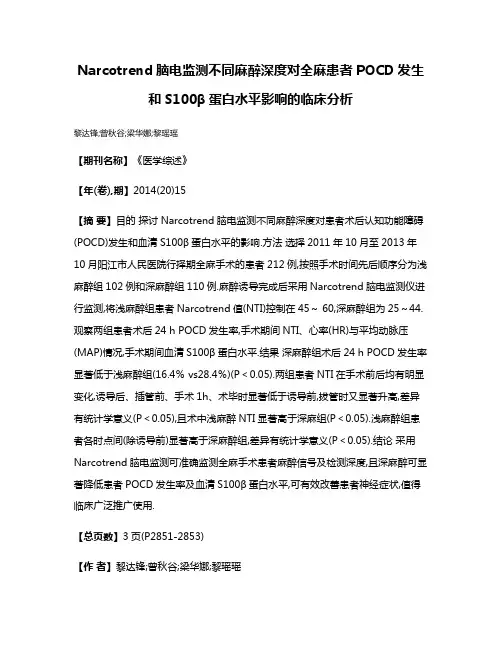
Narcotrend脑电监测不同麻醉深度对全麻患者POCD发生和S100β蛋白水平影响的临床分析黎达锋;曾秋谷;梁华娜;黎瑶瑶【期刊名称】《医学综述》【年(卷),期】2014(20)15【摘要】目的探讨Narcotrend脑电监测不同麻醉深度对患者术后认知功能障碍(POCD)发生和血清S100β蛋白水平的影响.方法选择2011年10月至2013年10月阳江市人民医院行择期全麻手术的患者212例,按照手术时间先后顺序分为浅麻醉组102例和深麻醉组110例.麻醉诱导完成后采用Narcotrend脑电监测仪进行监测,将浅麻醉组患者Narcotrend值(NTI)控制在45~ 60,深麻醉组为25~44.观察两组患者术后24 h POCD发生率,手术期间NTI、心率(HR)与平均动脉压(MAP)情况,手术期间血清S100β蛋白水平.结果深麻醉组术后24 h POCD发生率显著低于浅麻醉组(16.4% vs28.4%)(P<0.05).两组患者NTI在手术前后均有明显变化,诱导后、插管前、手术1h、术毕时显著低于诱导前,拔管时又显著升高,差异有统计学意义(P<0.05),且术中浅麻醉NTI显著高于深麻组(P<0.05).浅麻醉组患者各时点间(除诱导前)显著高于深麻醉组,差异有统计学意义(P<0.05).结论采用Narcotrend脑电监测可准确监测全麻手术患者麻醉信号及检测深度,且深麻醉可显著降低患者POCD发生率及血清S100β蛋白水平,可有效改善患者神经症状,值得临床广泛推广使用.【总页数】3页(P2851-2853)【作者】黎达锋;曾秋谷;梁华娜;黎瑶瑶【作者单位】阳江市人民医院麻醉科,广东阳江529500;阳江市人民医院麻醉科,广东阳江529500;阳江市人民医院麻醉科,广东阳江529500;阳江市人民医院麻醉科,广东阳江529500【正文语种】中文【中图分类】R614.2【相关文献】1.不同麻醉深度对老年患者术后认知功能和血清S100β蛋白水平的影响 [J], 杨吉安2.观察和分析不同麻醉方式及麻醉深度对老年患者TURP术后认知功能和血清S100-β蛋白水平的影响 [J], 梁荣丰;庄上英;赵子良3.不同麻醉深度对老年患者术后认知功能和血清S100-β蛋白水平的影响 [J], 李灵玲;罗雄英;陈涛;辜娟;郎义;钟强4.闭环靶控输注下不同麻醉深度对老年全身麻醉患者血清脂联素水平及POCD的影响 [J], 黄润成;张曙;谢海辉;黄韵枝5.BIS脑电双频指数监护仪监测不同麻醉深度对全麻患者POCD发生与S100β蛋白水平关系的临床分析 [J], 吴平蕾因版权原因,仅展示原文概要,查看原文内容请购买。
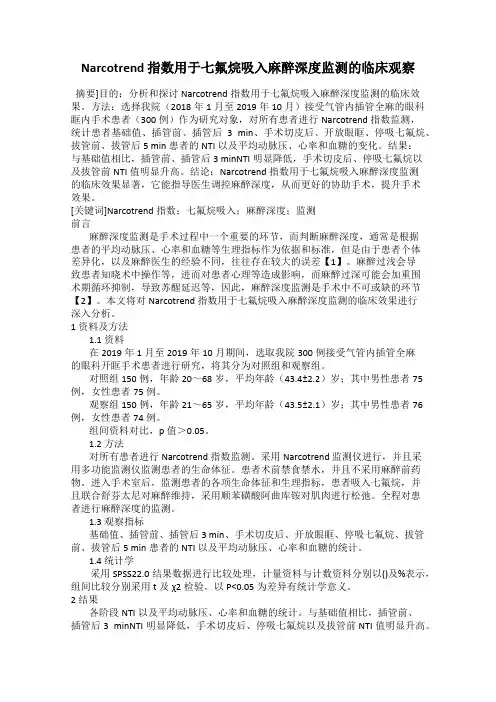
Narcotrend 指数用于七氟烷吸入麻醉深度监测的临床观察摘要]目的:分析和探讨Narcotrend指数用于七氟烷吸入麻醉深度监测的临床效果。
方法:选择我院(2018年1月至2019年10月)接受气管内插管全麻的眼科眶内手术患者(300例)作为研究对象,对所有患者进行Narcotrend指数监测,统计患者基础值、插管前、插管后 3 min、手术切皮后、开放眼眶、停吸七氟烷、拔管前、拔管后5 min患者的NTI以及平均动脉压、心率和血糖的变化。
结果:与基础值相比,插管前、插管后3 minNTI明显降低,手术切皮后、停吸七氟烷以及拔管前NTI值明显升高。
结论:Narcotrend指数用于七氟烷吸入麻醉深度监测的临床效果显著,它能指导医生调控麻醉深度,从而更好的协助手术,提升手术效果。
[关键词]Narcotrend指数;七氟烷吸入;麻醉深度;监测前言麻醉深度监测是手术过程中一个重要的环节,而判断麻醉深度,通常是根据患者的平均动脉压、心率和血糖等生理指标作为依据和标准,但是由于患者个体差异化,以及麻醉医生的经验不同,往往存在较大的误差【1】。
麻醉过浅会导致患者知晓术中操作等,进而对患者心理等造成影响,而麻醉过深可能会加重围术期循环抑制,导致苏醒延迟等,因此,麻醉深度监测是手术中不可或缺的环节【2】。
本文将对Narcotrend指数用于七氟烷吸入麻醉深度监测的临床效果进行深入分析。
1 资料及方法1.1资料在2019年1月至2019年10月期间,选取我院300例接受气管内插管全麻的眼科开眶手术患者进行研究,将其分为对照组和观察组。
对照组150例,年龄20~68岁,平均年龄(43.4±2.2)岁;其中男性患者75例,女性患者75例。
观察组150例,年龄21~65岁,平均年龄(43.5±2.1)岁;其中男性患者76例,女性患者74例。
组间资料对比,p值>0.05。
1.2 方法对所有患者进行Narcotrend指数监测。
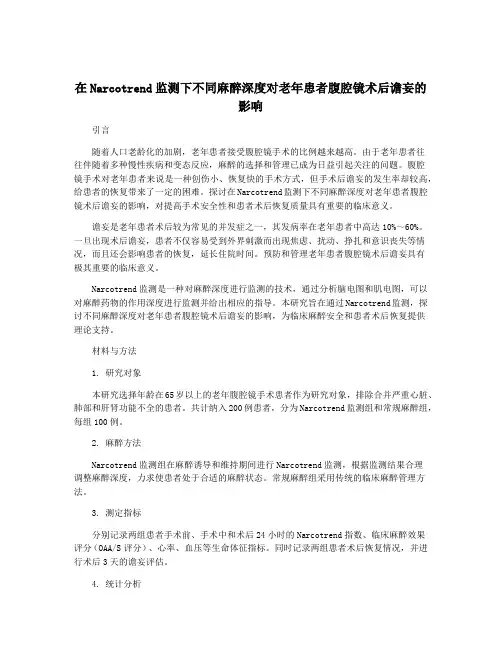
在Narcotrend监测下不同麻醉深度对老年患者腹腔镜术后谵妄的影响引言随着人口老龄化的加剧,老年患者接受腹腔镜手术的比例越来越高。
由于老年患者往往伴随着多种慢性疾病和变态反应,麻醉的选择和管理已成为日益引起关注的问题。
腹腔镜手术对老年患者来说是一种创伤小、恢复快的手术方式,但手术后谵妄的发生率却较高,给患者的恢复带来了一定的困难。
探讨在Narcotrend监测下不同麻醉深度对老年患者腹腔镜术后谵妄的影响,对提高手术安全性和患者术后恢复质量具有重要的临床意义。
谵妄是老年患者术后较为常见的并发症之一,其发病率在老年患者中高达10%~60%。
一旦出现术后谵妄,患者不仅容易受到外界刺激而出现焦虑、扰动、挣扎和意识丧失等情况,而且还会影响患者的恢复,延长住院时间。
预防和管理老年患者腹腔镜术后谵妄具有极其重要的临床意义。
Narcotrend监测是一种对麻醉深度进行监测的技术,通过分析脑电图和肌电图,可以对麻醉药物的作用深度进行监测并给出相应的指导。
本研究旨在通过Narcotrend监测,探讨不同麻醉深度对老年患者腹腔镜术后谵妄的影响,为临床麻醉安全和患者术后恢复提供理论支持。
材料与方法1. 研究对象本研究选择年龄在65岁以上的老年腹腔镜手术患者作为研究对象,排除合并严重心脏、肺部和肝肾功能不全的患者。
共计纳入200例患者,分为Narcotrend监测组和常规麻醉组,每组100例。
2. 麻醉方法Narcotrend监测组在麻醉诱导和维持期间进行Narcotrend监测,根据监测结果合理调整麻醉深度,力求使患者处于合适的麻醉状态。
常规麻醉组采用传统的临床麻醉管理方法。
3. 测定指标分别记录两组患者手术前、手术中和术后24小时的Narcotrend指数、临床麻醉效果评分(OAA/S评分)、心率、血压等生命体征指标。
同时记录两组患者术后恢复情况,并进行术后3天的谵妄评估。
4. 统计分析采用SPSS 20.0统计软件进行数据处理和分析,比较两组患者各项指标的差异,采用t 检验或χ2检验进行比较。
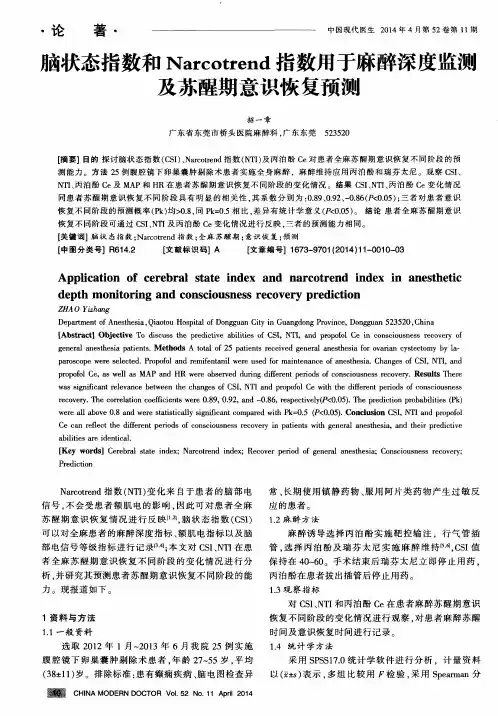
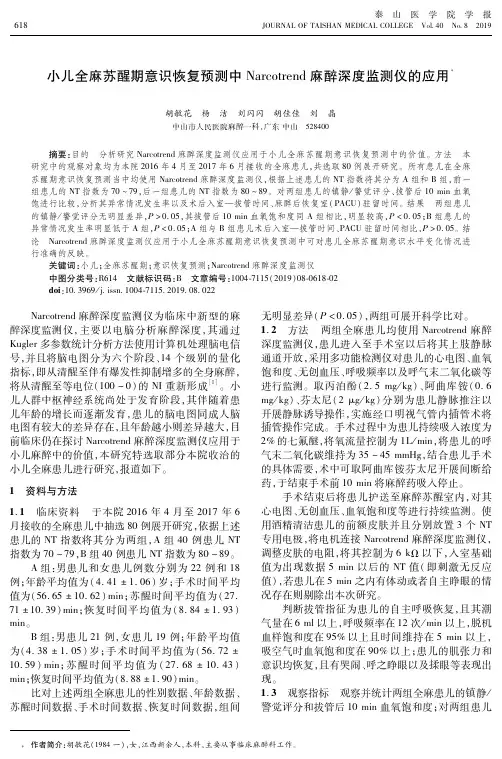
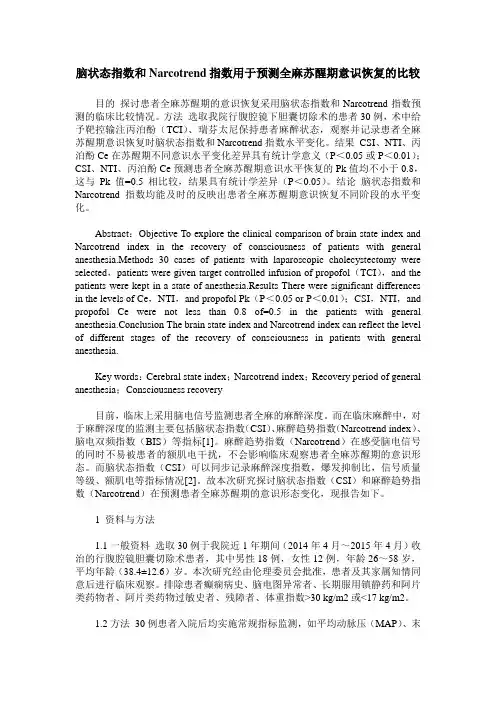
脑状态指数和Narcotrend指数用于预测全麻苏醒期意识恢复的比较目的探讨患者全麻苏醒期的意识恢复采用脑状态指数和Narcotrend指数预测的临床比较情况。
方法选取我院行腹腔镜下胆囊切除术的患者30例,术中给予靶控输注丙泊酚(TCI)、瑞芬太尼保持患者麻醉状态,观察并记录患者全麻苏醒期意识恢复时脑状态指数和Narcotrend指数水平变化。
结果CSI、NTI、丙泊酚Ce在苏醒期不同意识水平变化差异具有统计学意义(P<0.05或P<0.01);CSI、NTI、丙泊酚Ce预测患者全麻苏醒期意识水平恢复的Pk值均不小于0.8,这与Pk值=0.5相比较,结果具有统计学差异(P<0.05)。
结论脑状态指数和Narcotrend指数均能及时的反映出患者全麻苏醒期意识恢复不同阶段的水平变化。
Abstract:Objective To explore the clinical comparison of brain state index and Narcotrend index in the recovery of consciousness of patients with general anesthesia.Methods 30 cases of patients with laparoscopic cholecystectomy were selected,patients were given target controlled infusion of propofol(TCI),and the patients were kept in a state of anesthesia.Results There were significant differences in the levels of Ce,NTI,and propofol Pk(P<0.05 or P<0.01);CSI,NTI,and propofol Ce were not less than 0.8 of=0.5 in the patients with general anesthesia.Conclusion The brain state index and Narcotrend index can reflect the level of different stages of the recovery of consciousness in patients with general anesthesia.Key words:Cerebral state index;Narcotrend index;Recovery period of general anesthesia;Consciousness recovery目前,临床上采用脑电信号监测患者全麻的麻醉深度。
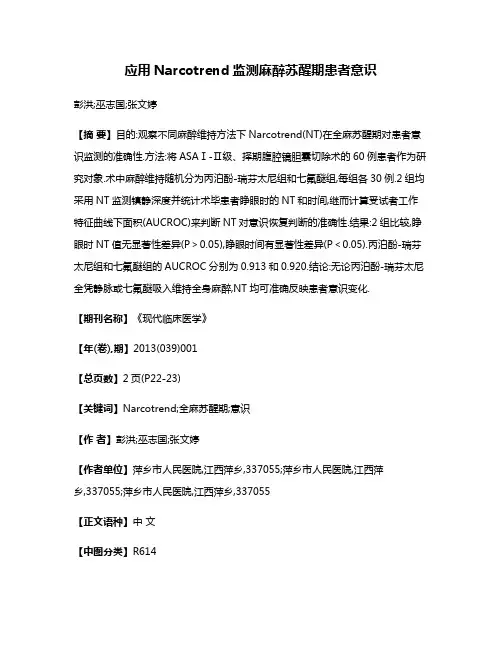
应用Narcotrend监测麻醉苏醒期患者意识彭洪;巫志国;张文婷【摘要】目的:观察不同麻醉维持方法下Narcotrend(NT)在全麻苏醒期对患者意识监测的准确性.方法:将ASAⅠ-Ⅱ级、择期腹腔镜胆囊切除术的60例患者作为研究对象.术中麻醉维持随机分为丙泊酚-瑞芬太尼组和七氟醚组,每组各30例.2组均采用NT监测镇静深度并统计术毕患者睁眼时的NT和时间,继而计算受试者工作特征曲线下面积(AUCROC)来判断NT对意识恢复判断的准确性.结果:2组比较,睁眼时NT值无显著性差异(P>0.05),睁眼时间有显著性差异(P<0.05).丙泊酚-瑞芬太尼组和七氟醚组的AUCROC分别为0.913和0.920.结论:无论丙泊酚-瑞芬太尼全凭静脉或七氟醚吸入维持全身麻醉,NT均可准确反映患者意识变化.【期刊名称】《现代临床医学》【年(卷),期】2013(039)001【总页数】2页(P22-23)【关键词】Narcotrend;全麻苏醒期;意识【作者】彭洪;巫志国;张文婷【作者单位】萍乡市人民医院,江西萍乡,337055;萍乡市人民医院,江西萍乡,337055;萍乡市人民医院,江西萍乡,337055【正文语种】中文【中图分类】R614Narcotrend(NT)是新近用于评价麻醉深度的脑电监测系统。
本研究将其用于丙泊酚-瑞芬太尼复合麻醉和七氟醚吸入全麻苏醒期监测,旨在比较这2种不同麻醉维持方法是否影响NT意识判断的准确性。
1.1 一般资料选择ASAⅠ-Ⅱ级、择期行腹腔镜胆囊切除手术的60例患者为研究对象。
患者中:男27例,女33例;年龄25~50岁。
将患者随机分为丙泊酚-瑞芬太尼组(简称丙-瑞组)和七氟醚组,每组各30例。
2组一般情况比较无显著性差异,具有可比性。
1.2 麻醉方法所有患者于术前30 min,常规肌注阿托品0.5 mg、苯巴比妥那100 mg。
入手术室后开放静脉通路,连接Philip多功能监护仪。
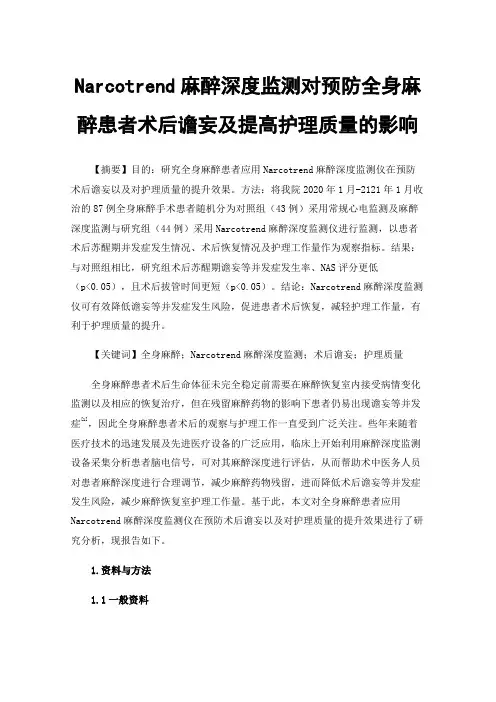
Narcotrend麻醉深度监测对预防全身麻醉患者术后谵妄及提高护理质量的影响【摘要】目的:研究全身麻醉患者应用Narcotrend麻醉深度监测仪在预防术后谵妄以及对护理质量的提升效果。
方法:将我院2020年1月-2121年1月收治的87例全身麻醉手术患者随机分为对照组(43例)采用常规心电监测及麻醉深度监测与研究组(44例)采用Narcotrend麻醉深度监测仪进行监测,以患者术后苏醒期并发症发生情况、术后恢复情况及护理工作量作为观察指标。
结果:与对照组相比,研究组术后苏醒期谵妄等并发症发生率、NAS评分更低(p<0.05),且术后拔管时间更短(p<0.05)。
结论:Narcotrend麻醉深度监测仪可有效降低谵妄等并发症发生风险,促进患者术后恢复,减轻护理工作量,有利于护理质量的提升。
【关键词】全身麻醉;Narcotrend麻醉深度监测;术后谵妄;护理质量全身麻醉患者术后生命体征未完全稳定前需要在麻醉恢复室内接受病情变化监测以及相应的恢复治疗,但在残留麻醉药物的影响下患者仍易出现谵妄等并发症[1],因此全身麻醉患者术后的观察与护理工作一直受到广泛关注。
些年来随着医疗技术的迅速发展及先进医疗设备的广泛应用,临床上开始利用麻醉深度监测设备采集分析患者脑电信号,可对其麻醉深度进行评估,从而帮助术中医务人员对患者麻醉深度进行合理调节,减少麻醉药物残留,进而降低术后谵妄等并发症发生风险,减少麻醉恢复室护理工作量。
基于此,本文对全身麻醉患者应用Narcotrend麻醉深度监测仪在预防术后谵妄以及对护理质量的提升效果进行了研究分析,现报告如下。
1.资料与方法1.1一般资料研究对象为我院2020年1月-2121年1月收治的87例全身麻醉手术患者,采用掷骰子分组法随机将所有患者分为两组。
其中,研究组44例,男女比例:24:20例;年龄18-72 岁,平均(49.64±7.23)岁,,对照组43例,男女比例:22:21例;年龄20-74 岁,平均(49.96±7.48)岁。
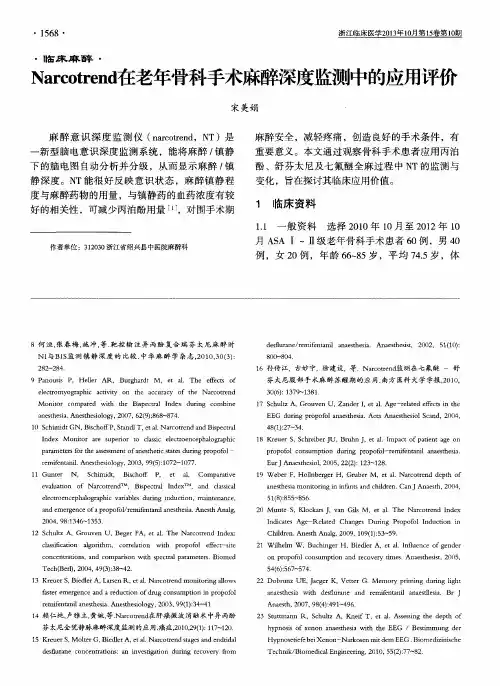
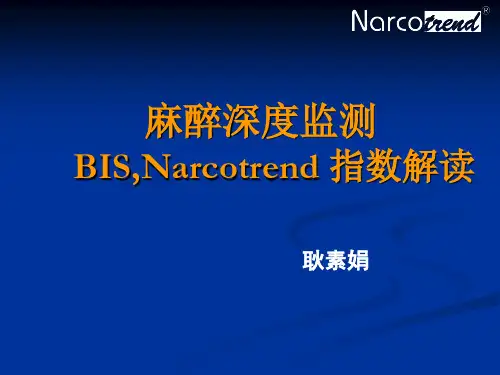

Narcotrend在老年患者全麻苏醒期意识恢复监测中的预判【摘要】目的评价Narcotrend(NT)在老年患者全麻苏醒期意识恢复的预判效能。
方法选择36例ASAⅡ~Ⅲ级在全麻下手术的老年患者,术中以瑞芬太尼和七氟醚维持麻醉。
术毕入麻醉恢复室,采用NT监测麻醉深度,在对刺激无反应、呼之睁眼、定向力恢复时记录NT分级(NTS)和NT 指数(NTI)、MAP和HR;计算比较这些参数对应意识变化的预测概率(Pk);记录对应OAA/S 评分值的NTS、NTI、MAP 和HR。
结果NTS、NTI与患者苏醒期意识水平的变化显著相关(P<0.05);NTS、NTI 预测患者睁眼时Pk值均显著高于0.5(P<0.05),也高于MAP 和HR 对应的Pk数值(P<0.05);OAA/S评分为3分、4分和5分的预测概率(Pk)数值明显高于0.5(P<0.05)。
结论NT 麻醉深度监测指标能够有效预判老年患者全麻苏醒期意识水平的变化。
【关键词】Narcotrend;全麻苏醒期;老年患者;镇静/警觉评分;预判麻醉意识深度监测技术的发展为精确实施麻醉提供了有效的技术手段,Narcotrend(NT)是一种新型麻醉意识深度监测仪,国内外研究发现其能够反映术中吸入或静脉全麻的麻醉深度变化[13]。
作者也观察发现其能够预判小儿全麻苏醒期意识的变化[4]。
但Narcotrend(NT)用于监测老年患者全麻苏醒期意识水平变化的研究较少。
本文旨在观察Narcotrend用于监测老年患者全麻苏醒期意识水平的变化,报告如下。
1 资料与方法1.1 一般资料选择2012年2月至2012年12月期间36例老年患者:男22例,女14例。
年龄最小65岁,最大82岁,体质量(56±14)kg,ASAⅠ级8例,Ⅱ级25例,Ⅲ级3例。
择期全麻手术患者:腹部手术20例,盆腔手术4例,四肢及脊柱手术(创伤性)12例,术前无严重肝肾功能障碍、精神疾病及听力障碍。
Anesthesiology2004;101:1105–11©2004American Society of Anesthesiologists,Inc.Lippincott Williams&Wilkins,Inc. Narcotrend®Does Not Adequately Detect the Transitionbetween Awareness and Unconsciousness in Surgical PatientsGerhard Schneider,M.D.,*Eberhard F.Kochs,M.D.,†Bettina Horn,M.D.,‡Matthias Kreuzer,M.Sc.,§Michael Ningler,M.Sc.§Background:The Narcotrend®index(MonitorTechnik,Bad Bramstedt,Germany)is a dimensionless number between0and 100that is calculated from the electroencephalogram and in-versely correlates with depth of hypnosis.The current study evaluates the capability of the Narcotrend®to separate aware-ness from unconsciousness at the transition between these levels.Methods:Electroencephalographic recordings of40unpre-medicated patients undergoing elective surgery were analyzed. Patients were randomly assigned to receive(1)sevoflurane–remifentanil(<0.1g·kg؊1·min؊1),(2)sevoflurane–remifen-tanil(>0.2g·kg؊1·min؊1),(3)propofol–remifentanil(<0.1g·kg؊1·min؊1),or(4)propofol–remifentanil(>0.2g·kg؊1·min؊1).Remifentanil and sevoflurane or propofol were given until loss of consciousness.After tracheal intubation, propofol or sevoflurane was stopped until return of conscious-ness and then restarted to induce loss of consciousness.After surgery,drugs were discontinued.Narcotrend®values at loss and return of consciousness were compared with each other, and anesthetic groups were compared.Prediction probability was calculated from values at the last command before and at loss and return of consciousness.Results:At105of316analyzed time points,the Narcotrend®did not calculate an index,and the closest calculated value was analyzed.No significant differences between loss and return of consciousness were found.In group1,Narcotrend®values were significantly higher than in group3.Prediction probability was 0.501.Conclusions:In these challenging data,the Narcotrend®did not differentiate between awareness and unconsciousness.In addition,Narcotrend®values were not independent from the anesthetic regimen.DURING the past decade,an increasing number of mon-itors have been developed for a direct assessment of anesthetic depth or the hypnotic component of anesthe-sia.This goal may be reached by observation of the spontaneous or evoked electrical activity of the brain, i.e.,the electroencephalogram,or(auditory)evoked po-tentials.The Narcotrend®(MonitorTechnik,Bad Bram-stedt,Germany)is one of the newer electroencephalo-gram-based monitors that promises quantification of the hypnotic component of ing a multivariate statistical algorithm,the Narcotrend®monitor quantifies anesthesia-induced electroencephalographic changes. This classification system is based on electroencephalo-graphic changes induced by sleep and was developed by Loomis et al.1The psychiatrist Kugler2adapted this clas-sification for anesthesia-induced electroencephalo-graphic changes,and this was further modified by Schultz et al.3Originally,classification results are given in a six-letter system with a total of14substages3:A:awarenessB0–2:sedationC0–2:light anesthesiaD0–2:general anesthesiaE0–1:general anesthesia with deep hypnosisF0–1:general anesthesia with increasing burst suppression.A recent study showed that Bispectral Index(BIS) values between40and64predominantly correspond with Narcotrend®stages D and E,representing general anesthesia.4In the latest version of the Narcotrend®,the alphanumerical classification was transformed into a nu-merical index that spans the range from0to100.The transform was performed in such a way that Narco-trend®ranges correspond to BIS ranges.Recently,it has been shown that Narcotrend®guidance of anesthesia may lead to reduced drug consumption and faster recov-ery from anesthesia.5However,few studies have been published that examined whether the Narcotrend®in-dex correctly indicates depth of hypnosis and anesthe-sia.Differentiation of a fully conscious from a deeply anesthetized patient may be achieved by routine clinical assessment.Differentiation between a patient with awareness under sedation and a patient who is just unconscious is by far more difficult.If a monitor of consciousness was able to identify the patient status at the transition between awareness and unconsciousness, it would clearly improve clinical assessment of sedation and hypnosis.The current study uses the challenging period of transition at loss of consciousness(LOC)and return of consciousness(ROC)to test the ability of Narcotrend®to differentiate between patients just aware and patients just unconscious.This analysis uses previ-ously recorded electroencephalographic data and exam-ines response to command as a clinical measure of an-esthetic depth.How well the Narcotrend®differentiates between electroencephalographic data that were re-corded during awareness and data that were recorded during unconsciousness in surgical patients is examined.*Assistant Professor,†Professor,Director,and Chair,‡Resident,§Research Fellow.Received from the Department of Anesthesiology,Klinikum rechts der Isar, Technische Universität München,Munich,Germany.Submitted for publication December10,2003.Accepted for publication June16,2003.Supported by a research fund of the Technische Universität München(KKF8768170),Munich, Germany,and in part by B.Braun AG,Melsungen,Germany.Address reprint requests to Dr.Schneider:Department of Anesthesiology,Klini-kum rechts der Isar,Technische Universität München,Ismaningerstr.22,81675 Munich,Germany.Address electronic mail to:Gerhard.Schneider@LRZ.tum.de. Individual article reprints may be purchased through the Journal Web site, .Materials and MethodsThe current study is a reanalysis of previously recorded electroencephalographic data.Electroencephalographic recordings were from induction of anesthesia until emer-gence and included a period of intended awareness after intubation.Patients gave informed written consent to the protocol that was approved by the university’s ethics committee(Technische Universität München,Munich, Germany)6and involved a reduction of the hypnotic agent until patients followed command after tracheal intubation.Digitally recorded electroencephalograms were replayed on a specifically designed digital/analog signal converter.This converter allows replay of re-corded electroencephalographic data as analog signals, i.e.,electric activity at the electrode recording sites.This signal may be used to test new electroencephalographic monitors(or updated versions of electroencephalo-graphic monitors)with previously recorded electroen-cephalographic data.7For the present analysis,electro-encephalographic data from40adult patients with American Society of Anesthesiologists physical status I or II who underwent elective surgery during general anesthe-sia were used.Exclusion criteria were rapid sequence in-duction,medication with drugs affecting the central ner-vous system,pregnancy,psychiatric,or neurologic diseases.Patients were randomly assigned to receive anes-thesia with one of the following drug combinations:(1) sevoflurane–remifentanil(Յ0.1g·kgϪ1·minϪ1),(2) sevoflurane–remifentanil(Ն0.2g·kgϪ1·minϪ1), (3)propofol–remifentanil(Յ0.1g·kgϪ1·minϪ1),or(4) propofol–remifentanil(Ն0.2g·kgϪ1·minϪ1).Moni-toring included noninvasive blood pressure;heart rate; oxygen saturation;oxygen,carbon dioxide,and sevoflu-rane concentrations;and respiratory parameters.All data were stored on a personal computer.At electroencepha-lographic electrode positions,the skin was prepared with alcohol to maintain impedances of less than5k⍀. Two-channel referential electroencephalogram was re-corded from electrode positions AT1,AT2,Fz(refer-ence),and Fp1(ground)using the A-1000electroen-cephalographic monitor(BIS®version 3.3;Aspect Medical Systems Inc.,Newton,MA).The high pass was set to0.25Hz,no low pass was used,and the notchfilter (50Hz)was enabled.The electroencephalogram was continuously digitized at256Hz/channel and simulta-neously recorded on the personal computer.Unpre-medicated patients received remifentanil infusion at ei-ther0.1or0.2g·kgϪ1·minϪ1according to the group assignment.Every30s,patients were asked to squeeze the investigator’s hand.To verify this response,the com-mand was immediately repeated,and the patient was required to squeeze the hand also to this repeated com-mand.Anesthesia was started with sevoflurane mask induction(groups1and2)or propofol injections (0.7mg/kg,followed by20mg every30s,groups3and 4).Loss of consciousness(LOC1)was defined as the time when the patient stopped squeezing hand to command. After LOC1,additional propofol or sevoflurane was given to increase the level of hypnosis.A blood pressure cuff was inflated on the right arm and maintained for5min to occlude the circulation of the right forearm and retain the ability to move the arm to command while succinyl-choline(1.0mg/kg)was given for intubation(isolated forearm technique of Tunstall).8Then,while remifen-tanil infusion was continued,sevoflurane or propofol was stopped until patients gave a verified response to command(return of consciousness[ROC1]).Sevoflu-rane or propofol bolus injection,followed by continuous infusion,was recommenced.Loss of consciousness2 (LOC2)was noted when patients stopped following commands and commands to squeeze the hand were stopped.Remifentanil was administered within the pre-defined remifentanil infusion rates.Sevoflurane and propofol were maintained according to clinical practice. At the end of surgery,commands to squeeze the hand were given every30s.Sevoflurane,propofol,and remifentanil were discontinued,and return of conscious-ness(ROC2)was noted at thefirst verified(i.e.,re-peated)response to command.Data AnalysisTo assess the ability of the Narcotrend®to differentiate between responsiveness and nonresponsiveness,the transition between these conditions was analyzed.The following Narcotrend®values were analyzed:at LOC1 and LOC2,the last value with a patient response(i.e., 30s before LOC)for“awareness”and thefirst value without patient response for“unconsciousness,”and accordingly at ROC1and ROC2,the last value without a patient response(i.e.,30s before ROC)for“uncon-sciousness”and thefirst value with patient response for “awareness.”Because one datafile was corrupted,this resulted in a total of316Narcotrend®index values.The Narcotrend®monitor did not always calculate index values at these times.In these instances,the closest value that had been calculated was selected,i.e.,the last index value that was calculated during responsiveness before LOC(or unconsciousness before ROC)and the first value that was obtained during unconsciousness after LOC(or responsiveness after ROC),and the accord-ing time delay was noted.Median and ranges of the time intervals between the last obtained and required Narco-trend®index during the transition between awareness and unconsciousness were calculated.The Narcotrend®values were used to calculate prediction probability(Pk) for discrimination between awareness and unconscious-ness as described by Smith et al.9In addition,statistical analysis was performed using a general linear model for repeated measurements.Narcotrend®values were com-pared among LOC1,ROC1,LOC2,and ROC2(within-subject factors).Narcotrend®values of the different1106SCHNEIDER ET AL.groups(1–4)were compared with each other(between-subject factor).Bonferroni corrections were used for post hoc tests of within-subject and between-subject factors.Overall significance was set at PϽ0.05(Bonfer-roni correction).Statistical analysis was performed with SPSS(SPSS Inc.,Chicago,IL).Pk values were calculated with an Excel(Microsoft®,Redmond,WA)Macro(PK-MACRO).Values are mean(SD)unless stated otherwise. After analysis,we were concerned that our method of data recording and presentation to the Narcotrend®monitor may have influenced the data in such a way that Narcotrend®values may have been influenced.In par-ticular,aliasing noise may have been produced.There-fore,with approval from the local ethics committee,we performed an additional measurement in a volunteer receiving remifentanil–propofol anesthesia.In this vol-unteer,0.2g·kgϪ1·minϪ1remifentanil was adminis-tered,and propofol target-controlled infusion was started.Every5min,the propofol target was increased until LOC occurred.This level was maintained for15 min.Next,the target level was increased until electro-encephalographic burst suppression occurred.This level was also maintained for15min,and then propofol was stopped.After ROC,remifentanil infusion was stopped. During this period,the electroencephalogram was re-corded with the identical method(Aspect A-1000with a sample rate of256Hz).Synchronously,the Narcotrend®was applied,and the Narcotrend®index was recorded with the Windows HyperTerminal program(Hilgraeve, Monroe,MI).Subsequently,recorded electroencephalo-graphic data were replayed three times,and during each replay,the Narcotrend®index was calculated from the digitized electroencephalogram.Recalculated Narco-trend®results were compared to the directly recorded Narcotrend®values.ResultsAnalysis was planned for Narcotrend®values at the transition between awareness and unconsciousness at induction(LOC1),the awareness period(ROC1and LOC2),and return of consciousness after surgery (ROC2).At each of these events,the last value before and thefirst value after the transition(i.e.,at LOC,the last value with and thefirst value without response to command,and at ROC,the last value without and the first value with response to command)were considered for analysis.One datafile was corrupted,and ROC1and LOC2could not be analyzed.At105of the remaining 316time points,the Narcotrend®did not calculate index values.As a consequence,the closest calculated Narco-trend®value was analyzed.This reduced the number of missing data to15,i.e.,for15measurements,no calcu-lated index value was available despite of an extended time window.The remaining15values were only from patients with a low remifentanil infusion rate(groups1 and3)at LOC1.Here,the Narcotrend®did not calculate an index and often indicated high-frequency artifacts. Table1shows the time interval between the clinical event and the closest time when the Narcotrend®gave an index value.This time interval was between3and 563s.Pk for the differentiation between awareness and unconsciousness was0.501(SEϭ0.033).A repeated-measurement general linear model did notfind signifi-cant differences between LOC or ROC(fig.1).Analysis of between-subject factors revealed that Narcotrend®values were not independent from the drug combina-tion.In group1,Narcotrend®values at LOC and ROC were significantly higher than in group3.The additional comparison of recalculated Narco-trend®values with the directly recorded Narcotrend®found that no index was calculated in28%in the direct measurement and between22%and28%of the recalcu-lated data.During most of the periods with missing Table1.Missing NarcotrendIndex ValuesNo Index,nTime Interval Without Index,s,Median(Range)LOC15932(3–515)ROC11873(6–563)LOC23247(4–345)ROC248.5(5–90)Number of scheduled analysis times where Narcotrendாdid not calculate an index(no index)and the time intervals to the closest calculated Narotrendாindex value at loss of consciousness(LOC1),awareness reaction(ROC1),loss of consciousness after the awareness reaction(LOC2),and return of con-sciousness at the end of anesthesia(ROC2).Fig. 1.Narcotrend®index at loss of consciousness(LOC1), awareness reaction(ROC1),loss of consciousness after the awareness reaction(LOC2),and return of consciousness at the end of anesthesia(ROC2).Thefigure shows individual values, mean(solid lines)and SD(dashed lines)of all patients in groups:(1)“low”remifentanil(0.1g·kg؊1·min؊1)–sevoflu-rane( ),(2)“high”remifentanil(0.2g·kg؊1·min؊1)–sevoflu-rane(‘),(3)“low”remifentanil–propofol(⅙),and(4)“high”remifentanil–propofol(F).Prediction probability(Pk)(SE)of the Narcotrend®for detection of consciousness is given.The dotted line shows the recommended upper level of Narcotrend®for general anesthesia.1107NARCOTREND®MAY NOT DETECT AWARENESSvalues,the monitor indicated high-frequency(muscle) artifacts.A minor part of missing values was from peri-ods of automated electrode impedance check.Seventy-five percent of the reanalyzed Narcotrend®values were identical or did not differ by more than5;an additional 17%showed a difference between6and10.Only8%of the recalculated values showed index values that dif-fered by more than10.These differences also existed between each of the reanalyzed values.DiscussionThese data show that in this challenging data set from loss and return of consciousness,the Narcotrend®was not able to differentiate between awareness and uncon-sciousness.Narcotrend®values showed considerable variation at specific levels of anesthesia(i.e.,loss and return of consciousness).Such index variability has been described for the BIS6,10–13and the patient state index (PSI).6As the current study shows,this problem also exists for the Narcotrend®.In an editorial,Drummond14 defined requirements for a depth-of-anesthesia monitor. Not only must the average values of an index be statis-tically different between different levels of anesthesia or sedation,but the measurement of an individual patient must indicate his or her current level of anesthesia.An overlap between the range of values for different stages of sedation and anesthesia must be avoided.15As our data show,none of these requirements was achieved by the Narcotrend®.In contrast to the BIS and the PSI, where for the identical data sets the mean values of unconsciousness and awareness showed a statistically significant difference,6this difference was not measured by the Narcotrend®.This is also reflected by a low Pk.Pk has been recommended to measure the performance of an index of anesthetic depth.Pk is not influenced by a selected threshold value and can be used to quantify the ability of an index to discriminate different levels of anesthesia.9A Pk of0is obtained when an monitor indicates exactly the opposite of the clinical status,i.e., every conscious patient is classified as unconscious and vice versa.A Pk of1means correct classification for every measurement,and a Pk of0.5is obtained when the index is as good as chance(e.g.,flipping a coin).In the current study,Pk for the Narcotrend®was only0.501, i.e.,not much better than a random process.A potential drawback of the current approach is the use of pooled data from four transitions between awareness and un-consciousness.If the Narcotrend®value at the transition between awareness and unconsciousness is relatively stable in the individual patient,the use of pooled data may inadequately increase the overall Pk.We have,as have others before us,16,17accepted the limitation of this approach.The results of the current analysis revealed high intraindividual variability,i.e.,in the individual pa-tient,ROC1occurred at index values that were different from values at ROC2(fig.2),which reduces the risk of inappropriately high Pk values.In addition,Pk was not much higher than chance(Pkϭ0.5),which makes an inadequate increase of Pk unlikely.Sixty-two of the79Narcotrend®values that were mea-sured during ROC were below65.Therefore,Narco-trend®indicated moderate or even(excessively)deep anesthesia,whereas the patient showed an awareness reaction,i.e.,responded adequately to the command to squeeze the investigator’s hand.Mean Narcotrend®val-ues at both LOC and ROC were between45and50, suggesting a deeper level of hypnosis.Only infive patients did the awareness reaction occur within5min after succinylcholine administration.The median time interval between succinylcholine adminis-tration and awareness was14min4s(minimum,1min 43s;maximum,32min47s).The Narcotrend®had problems calculating index values and often showed an error warning that high-frequency(muscle)artifacts were present.As a consequence of these problems,no index value was calculated in105of316transition periods,where the level of hypnosis substantially changed,i.e.,the transition between awareness and un-consciousness occurred.A complete absence of infor-mation was noted for15of the80planned measure-ments during LOC1at induction.This complete failure of the monitor only occurred in patients receiving the low infusion rate of remifentanil.The electroencephalo-gram of these patients often showed high-frequency ac-tivity(Ͼ30Hz).This activity may mainly reflect muscle activity(electromyography)rather than electroencepha-lographic activity and often caused the Narcotrend®not to calculate an index value.In contrast to the Narco-trend®,this high-frequency activity did not stop the BIS or the PSI from calculating index values in the same patients.6This observation may indicate a clinically rel-evant difference between the Narcotrend®and the BIS or the PSI,illustrating a limitation for the clinical appli-cation of Narcotrend®.In most instances where Narco-trend®had not calculated an index value,there was at least a preceding(or following)value for the same pa-tient state.There was a remarkable duration of periods without index calculation,especially during LOC(79 and68s)but also during the awareness reaction(96s), with maxima up to almost10min.During these dynamic phases,such a time interval may mean that the patient state has substantially changed in the meantime.This also has consequences for the current data analysis. Numerous index values were not taken directly from the transition between awareness and unconsciousness or vice versa,and there was a remarkable distance to the clinical endpoint LOC or ROC.The analyzed Narco-trend®values are a longer time interval away from the transition periods,i.e.,the measured index values are also further away from the index range of transition1108SCHNEIDER ET AL.between awareness and unconsciousness.Therefore,separation between these data should be easier,and Pk values should be higher than Pk values that were derived directly from the transition points.In contrast to these expectations,Pk values of the Narcotrend ®were lower than Pk values of the BIS or the PSI,even though for the BIS and the PSI the data from the transitions (a more challenging data set)had been used.In a previous study that examined the separation be-tween steady state anesthesia and responsiveness during emergence from anesthesia,Pk of the BIS was lower than Pk of the Narcotrend ®.The authors stated that the lower Pk of the BIS may result from the facts that BIS calculation requires approximately 30s and that they did not compensate for this calculation interval.18In our data analysis,where this time compensation had been performed,6Pk of the BIS was higher than Pk of the Narcotrend ®.Electroencephalographic data were collected with the Aspect A-1000monitor.Results show that the BIS,the index value that is calculated by this monitor,separates between unconsciousness and awareness better than the Narcotrend ®when the same raw electroencephalo-graphic data are used.Results of the current analysis support the use of the monitor that had originally been used to collect the electroencephalographic data.This may reflect a potential bias.Therefore,the comparison of direct Narcotrend ®measurement from a volunteer and subsequent measurement from the volunteer’s elec-troencephalogram was performed.In this volunteer,all levels from light sedation to deep hypnosis (reflected by electroencephalographic burst suppression)were mea-sured.Both the original Narcotrend ®recordings and the analysis of the replayed electroencephalogram con-tained comparable time intervals with high-frequency artifacts.This excludes the hypothesis that in there-Fig.2.Narcotrend ®index at loss of consciousness (LOC1),awareness reaction (ROC1),loss of consciousness after the awareness reaction (LOC2),and return of consciousness at the end of anesthesia (ROC2).The graphs show the 30-s transition intervals from the last response to command to the first command to which the patient did not respond (“squeeze hand”)(LOC)and vice versa (ROC).Individual patient curves are shown for group 1(A ),sevoflurane/remifentanil (<0.1g ·kg ؊1·min ؊1);group 2(B ),sevoflurane–remifentanil (>0.2g ·kg ؊1·min ؊1);group 3(C ),propofol–remifentanil (<0.1g ·kg ؊1·min ؊1);and group 4(D ),propofol–remifentanil (>0.2g ·kg ؊1·min ؊1).At the transition intervals,numerous values were not calculated by the Narcotrend ®.The figure shows between-and within-patient variability.1109NARCOTREND ®MAY NOT DETECT AWARENESSplayed electroencephalographic data,aliasing artifacts had led to additional high-frequency noise,which could have induced additional artifact periods.Only8%of Narcotrend®values showed a difference greater than10 between the original recording and the reanalysis from the recorded electroencephalographic data.This differ-ence existed not only between the on-line Narcotrend®recording and each of the three off-line measurements, but also between the off-line measurements.These dif-ferences are most likely due to minimal time differences: Five-second segments of the electroencephalogram are used to calculate a Narcotrend®value.Small differences (in the range of milliseconds)in start times of the Nar-cotrend®monitor lead to different5-s segments.This explains why a small percentage of Narcotrend®values are different not only between the original recording and the recalculated index,but also between the three off-line calculations of Narcotrend®values. Interestingly,Narcotrend®values were not indepen-dent from the anesthetic regimen at identical clinical endpoints.Narcotrend®values of patients receiving sevoflurane anesthesia with a low infusion rate of remifentanil(0.1g·kgϪ1·minϪ1,group1)were significantly higher than values measured in patients with propofol and a low infusion rate of remifentanil (group3).This difference suggests that the use of iden-tical Narcotrend®ranges as a guide for anesthesia would induce different levels of hypnosis depending on the anesthetic drug combination,and the Narcotrend®in-dex may be drug specific.In the current study,awareness was defined as the adequate response to a verbal command(awareness re-action).To exclude the possibility that randomly occur-ring movements of the hand are erroneously counted as awareness reaction,an obeyed command was immedi-ately repeated,and a response was only counted as response when the patient squeezed hand again.The ability to respond to a command indicates intact short-term or working memory,a memory function of limited capacity that spans a few seconds.This must not be confused with explicit long-term memory,which is usu-ally thought of when the term memory is used.The difference between short-term and explicit long-term memory explains why none of our patients remembered being aware(long-term explicit memory)even though this had occurred in all patients(short-term memory). Absence of a response to a command may be a conser-vative measure of an adequate level of hypnosis,because the ability to respond to a command does not cause recall of the period.However,absence of explicit long-term memory may not be not sufficient for general an-esthesia,because implicit(unconscious)memory may be present19and associated with wakefulness and could have long-term consequences.20,21In addition,it has been demonstrated that increased duration of respon-siveness increases the risk of explicit memory.22Few validation data have been published for the Nar-cotrend®index.A previous study compared parallel re-cordings of the BIS and the Narcotrend®and found a decrease of BIS values with decreases of Narcotrend®index values.4However,there were several data pairs where one index did not confirm the results of the other index.There was no explanation for this disagreement, and the authors concluded that there should be“further investigations on sensitivity and specificity of the dis-played monitor results.”4Two publications examined Narcotrend®values during propofol–remifentanil anes-thesia and found conflicting results.Analysis of data recorded during emergence from anesthesia resulted in the conclusion that“modern EEG variables did not pro-vide an adequate assessment of depth of anesthesia when remifentanil was used.”23However,analysis of intraoperatively recorded data suggested that“modern electroencephalographic parameters,especially Narco-trend®,are more reliable indicators for the clinical as-sessment of anesthetic states than classic parameters.”18 In this previous study,Narcotrend®values allowed a good separation between steady state anesthesia and the first response during emergence(Pkϭ0.9),and perfor-mance of the Narcotrend®was superior to the BIS®monitor.18In the current analysis,Pk was only0.5for Narcotrend®.This is because two very similar signals were used for analysis,electroencephalograms from pa-tients that were just unresponsive and from patients who were just following command at the transition from awareness to unconsciousness,which represents a chal-lenging data set.To the best of our knowledge,no other articles have been published that have tried to correlate Narcotrend®values with clinical measurements of the sedative or hypnotic component of anesthesia.We suggest that a thorough validation of the Narcotrend®must be per-formed before it is used to guide the administration of anesthetic agents.Otherwise,the index may falsely sug-gest inadequate levels of anesthesia, e.g.,excessively deep anesthesia during adequate levels.This in turn would result in a reduction of anesthesia and possibly increase the risk of awareness.In an editorial about the use of the BIS in pediatric patients,Watcha24explained the importance of a thorough validation of a hypnosis monitor before its use as a guide for the administration of anesthetic agents.The same principles are relevant for every monitor of sedation and hypnosis,because“in clinical investigations,as in other matters,first things should comefirst.”24References1.Loomis AL,Harvey EN,Hobart CA:Cerebral states during sleep as studied by human brain potentials.J Exp Psychol1937;21:127–442.Kugler J:Elekroenzephalographie in Klinik und Praxis,3rd edition.Stutt-gart,New York,Thieme,1981,pp35–613.Schultz B,Grouven U,Schultz A:Automatic classification algorithms of the1110SCHNEIDER ET AL.。
Narcotrend脑电监测不同麻醉深度对全麻患者POCD发生和S100β蛋白水平影响的临床分析黎达锋;曾秋谷;梁华娜;黎瑶瑶【摘要】目的探讨Narcotrend脑电监测不同麻醉深度对患者术后认知功能障碍(POCD)发生和血清S100β蛋白水平的影响.方法选择2011年10月至2013年10月阳江市人民医院行择期全麻手术的患者212例,按照手术时间先后顺序分为浅麻醉组102例和深麻醉组110例.麻醉诱导完成后采用Narcotrend脑电监测仪进行监测,将浅麻醉组患者Narcotrend值(NTI)控制在45~ 60,深麻醉组为25~44.观察两组患者术后24 h POCD发生率,手术期间NTI、心率(HR)与平均动脉压(MAP)情况,手术期间血清S100β蛋白水平.结果深麻醉组术后24 h POCD发生率显著低于浅麻醉组(16.4% vs28.4%)(P<0.05).两组患者NTI在手术前后均有明显变化,诱导后、插管前、手术1h、术毕时显著低于诱导前,拔管时又显著升高,差异有统计学意义(P<0.05),且术中浅麻醉NTI显著高于深麻组(P<0.05).浅麻醉组患者各时点间(除诱导前)显著高于深麻醉组,差异有统计学意义(P<0.05).结论采用Narcotrend脑电监测可准确监测全麻手术患者麻醉信号及检测深度,且深麻醉可显著降低患者POCD发生率及血清S100β蛋白水平,可有效改善患者神经症状,值得临床广泛推广使用.【期刊名称】《医学综述》【年(卷),期】2014(020)015【总页数】3页(P2851-2853)【关键词】Narcotrend脑电监测;不同麻醉深度;术后认知功能障碍;S100β蛋白【作者】黎达锋;曾秋谷;梁华娜;黎瑶瑶【作者单位】阳江市人民医院麻醉科,广东阳江529500;阳江市人民医院麻醉科,广东阳江529500;阳江市人民医院麻醉科,广东阳江529500;阳江市人民医院麻醉科,广东阳江529500【正文语种】中文【中图分类】R614.2术后认知功能障碍(postoperative cognitive dysfunction,POCD)是指老年患者麻醉术后中枢神经系统出现的并发症,患者临床常出现焦虑、精神错乱、人格改变、记忆缺失等,患者人格、认知及社交能力出现变化,是术后常见并发症之一。